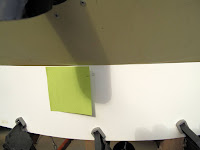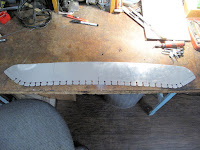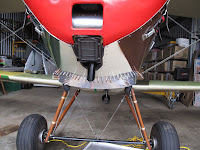Fixing seal leaks didn't solve the Cylinder Head Temperature (CHT) problem. I have nice big inlets with the Taylorcraft nose bowl, so my next area to work on is the outlet opening. When I made the new sheet metal I tried to duplicate all this as carefully as possible so it surprises me to be having cooling problems.
The outlet has a skirt, like a cowl flap, which is about 4" tall and hasn't changed since shortly after we built the plane.
I started by checking the angle it's tipped back. From old photos it was tipped back at 125 degrees. I have this nice antique folding ruler. The center joint is stiff enough that it works nice for measuring angles. Using my best protractor the new skirt measures 130 degrees. I'm not sure that's enough difference to matter, but my friend Fred suggested a way to adjust this angle.
The idea was to cut off the flange on the ends of the skirt and replace them with brackets to allow the skirt to be bolted at different angles.
I worked out a pattern of 4 bolt holes which allow the shirt to be tipped in 3 different positions with 2 3/16" bolts holding it together in each position. In the center position the 2 outer holes are used. In the other 2 positions an outer bolt and it's inner neighbor are used. This allows the skirt to be at 125, 130 or 135 degrees. We'll see if it matters.
Once I had this done I realized I'm more likely to get better cooling with a larger outlet opening than the angle of the skirt.
Some quick measurements showed I could move the ends of the skirts outboard 1" and still clear the exhaust pipes. That would add about 8 square inches to the outlet opening.
I decided to also move it forward 1". I took the cut out piece, scanned it, and brought it up in TurboCAD. This allowed me to draw the outlines of the old and new openings to measure their areas. The old opening was 61.4 Sq. In. The new one is 86.9 Sq. In., that's an increase of 25.5 Sq. In. or 41.5%. That seems like a good change.
Rather than make a whole new skirt I cut it in half and put the cowl back on the plane. Then I fitted up a piece to fill the gap, with a backing plate to tie it all together. It worked fine.
The next thing was to prevent air going in the openings around the exhaust pipes. I increased the openings about 1/4" all the way around to give the pipe some more clearance. It looked like the pipe had rubbed on the cowl at some point in the past. Because of the angle on the bottom of the cowl, that extra gap may be letting air in, reducing the pressure drop across the cylinders.
My research on line shows that the air pressure on top (inlet side) of the cylinders should be about 5-8 inches of water higher than on the bottom (outlet side). I think I've figured out how to mount a U-tube manometer to measure this if needed.
For now my plan was just to make some skirts around the pipe openings to prevent air entering.
The skirts have tabs for riveting them to the cowling. I cleco'd the long side flange in place and used stacks of popsicle sticks to wedge the skirts in place to mark the other tab holes.
Back to the attic to rivet it all together.
It was a bit of a pain to hold and rivet by my self. I eventually pulled a bungee cord across it which made it easy to hold.
Everything is done and back on the plane. I'll pretty it up once it all works.
I've made 2 flights with all this. On the first flight I had the skirt in the center, 130 degree, position. The problem is not solved but it was a big change. In level flight the CHT dropped from 460 degrees F to 415-420. I'd like it in the range of 360-390 degrees F, but this is going in the right direction. The oil temp after 25 minutes had slowly climbed to 185 degrees F. It was 210 degrees after 15 minutes before so the motor is running cooler.
For the second flight I moved the skirt to the shallower 135 degree position, No change.
I did have two nice flights just before sunset and the plane flies great. I can feel a difference in how the plane turns when well coordinated and when 1 ball width off, so I should be able to learn to feel when I'm making good turns.
Last night I also tried the cabin heat. It works great and creates a nice bubble of warm air in the whole cockpit, very good. I should be able to fly most of the winter here in Virginia.
I'll try the 125 degree position next flight. After that I'll work on the manometer and consider moving the skirt forward another inch. I also need to look at possible air leaks by the carburetor.
I'm having fun with all this.
































































